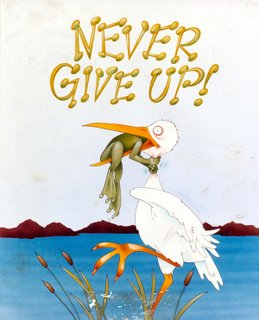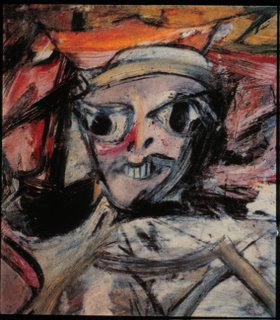Monday, November 27, 2006
Currin Rakes It In
The sexual imagination of the Heterosexual Male is John Currin's playground. All women submit to His gaze, as irresistible as X-ray as it undresses its subjects, elaborating on the lace lingerie. In these paintings, women are pleasant scenery or fine china, literally: sharing a table top with the settings of a Dutch still life, a gangly model escapes Egon Schiele's studio to pose for Currin. Still, she's just another object, albeit less shiny. Yet simultaneously, Currin's fleshy nymphs, ladies, and broads brim with vivacious personality.
Each woman is oblivious to her sitting-duck objectification, too busy aching for a substantial man to appear and pound away her aching desire. Or she dreams of a buxom blonde. Girl-on-girl is just fine (as long as we can watch and as long as they are not ugly lesbians). But don't look for Jack Twist and Ennis Del Mar. Same-sex pairings evade men in Currin's new paintings; a second man never appears to compromise our champion.
Either way, the man is on top and the women are on their backs. One exception is "Copenhagen," a menage a trois in which one woman straddles the man. On top, she seems dominant. Another woman steers her onto the man's erection, empowered in this directorial role. So the man appears to be doubly submissive. These women so dominate the pictorial space that they swallow his head (er, both heads). But his erection prevails, refusing to surrender. It's like the ubiquitious folk poster, "Never Give Up."

Male painters easily make misogynistic mistakes, real or imagined. Currin trudges through this minefield oafishly, yet manages it with panache. He exposes his sexism, loud and proud. Like a butcher sizing up stock, Currin counts only the choice parts: perky tits, doe eyes, plump lips. And like Picasso, Currin tries to cram all the good stuff into the picture. Currin's dolls share a gaze that looks spacey, vapid, and needy. You don't laugh with them, you laugh at them.
On the other hand, Currin lovingly relishes the curves and bulges of the female figure. He models and renders form, and the figures burst from Currin's silvery palette, reminiscent of the lush "Barry Lyndon." All this care suggests sincerity that neutralizes his ironic tendencies. Compare to David Salle's murky, bland photorealism or Cotton's superacademic, hyperkitsch models, available in chocolate or strawberry. Meanwhile, DeKooning battered women down to fluid scribbles and angular strokes.

Does Currin love women or hate them? Rather, what does he love/hate about women? He said in a Flash Art interview: I don't love women, I just think about them all of the time.
I love to look at women; they stimulate my imagination and not just in a sexual way.
I used to love watching women hobbling in their new shoes down fourteenth street.
I saw myself in them. I get a perspective on myself when looking at a woman, her beauty, her ugliness, her failures.
Six or seven paintings - less than half of the show - are sex pictures. The others are "chick paintings," including a portrait of his fully clad spouse, in "Federal Rachel." Another clothed woman is the fruit-bearing brunette in "The Christian," a hilarious prude suffering the fornicating heathens. More hilarious is "Anna" a Christopher Guest-cast nerd in her late 30s who smiles all too warmly from behind a candlestick and ripe banana.

The clues to a narrative arc are two portraits of Currin's son, Francis, and a future portrait, "2070," where Francis appears as a post-sex old man. This, and the neighboring baby portrait are bookends to the chapters of adult sexual adventure of Francis, something like Hockney's or Hogarth's "The Rake's Progress" - maybe that's what Francis 2070 is reading! Alas, like Father, like Son; Francis likes his whores, but loves his Madonna - again, "Federal Rachel." He may be a womanizer, but our polyester-suited, gallant gentleman still courts his women with white wine and a sunny day.
Each woman is oblivious to her sitting-duck objectification, too busy aching for a substantial man to appear and pound away her aching desire. Or she dreams of a buxom blonde. Girl-on-girl is just fine (as long as we can watch and as long as they are not ugly lesbians). But don't look for Jack Twist and Ennis Del Mar. Same-sex pairings evade men in Currin's new paintings; a second man never appears to compromise our champion.
Either way, the man is on top and the women are on their backs. One exception is "Copenhagen," a menage a trois in which one woman straddles the man. On top, she seems dominant. Another woman steers her onto the man's erection, empowered in this directorial role. So the man appears to be doubly submissive. These women so dominate the pictorial space that they swallow his head (er, both heads). But his erection prevails, refusing to surrender. It's like the ubiquitious folk poster, "Never Give Up."

Male painters easily make misogynistic mistakes, real or imagined. Currin trudges through this minefield oafishly, yet manages it with panache. He exposes his sexism, loud and proud. Like a butcher sizing up stock, Currin counts only the choice parts: perky tits, doe eyes, plump lips. And like Picasso, Currin tries to cram all the good stuff into the picture. Currin's dolls share a gaze that looks spacey, vapid, and needy. You don't laugh with them, you laugh at them.
On the other hand, Currin lovingly relishes the curves and bulges of the female figure. He models and renders form, and the figures burst from Currin's silvery palette, reminiscent of the lush "Barry Lyndon." All this care suggests sincerity that neutralizes his ironic tendencies. Compare to David Salle's murky, bland photorealism or Cotton's superacademic, hyperkitsch models, available in chocolate or strawberry. Meanwhile, DeKooning battered women down to fluid scribbles and angular strokes.

Does Currin love women or hate them? Rather, what does he love/hate about women? He said in a Flash Art interview: I don't love women, I just think about them all of the time.
I love to look at women; they stimulate my imagination and not just in a sexual way.
I used to love watching women hobbling in their new shoes down fourteenth street.
I saw myself in them. I get a perspective on myself when looking at a woman, her beauty, her ugliness, her failures.
Six or seven paintings - less than half of the show - are sex pictures. The others are "chick paintings," including a portrait of his fully clad spouse, in "Federal Rachel." Another clothed woman is the fruit-bearing brunette in "The Christian," a hilarious prude suffering the fornicating heathens. More hilarious is "Anna" a Christopher Guest-cast nerd in her late 30s who smiles all too warmly from behind a candlestick and ripe banana.

The clues to a narrative arc are two portraits of Currin's son, Francis, and a future portrait, "2070," where Francis appears as a post-sex old man. This, and the neighboring baby portrait are bookends to the chapters of adult sexual adventure of Francis, something like Hockney's or Hogarth's "The Rake's Progress" - maybe that's what Francis 2070 is reading! Alas, like Father, like Son; Francis likes his whores, but loves his Madonna - again, "Federal Rachel." He may be a womanizer, but our polyester-suited, gallant gentleman still courts his women with white wine and a sunny day.
Sunday, November 19, 2006
Sea and Seams
Jennifer Steinkamp and Barnaby Furnas. Can you believe that these two shows simultaneously coexisted in Chelsea? Sweeping swells + spectacular scale = Sublime. Don't take our word for it; look here!


Jennifer Steinkamp's LCD projections are innovative, but embrace art historical concerns. Take the ubiquitous garment study, for example. Her tumbling handerkerchiefs twist, roll, and fold in a straight line from ceiling to floor over quasi-bodily shapes, thereby mapping those shapes, twinkling in the light of the projection. Steinkamp shares our vulnerability to some paintings from the 16th-19th century, which get us hot from just the deftly-rendered drapery contained in their rectangular borders!





Jennifer Steinkamp's LCD projections are innovative, but embrace art historical concerns. Take the ubiquitous garment study, for example. Her tumbling handerkerchiefs twist, roll, and fold in a straight line from ceiling to floor over quasi-bodily shapes, thereby mapping those shapes, twinkling in the light of the projection. Steinkamp shares our vulnerability to some paintings from the 16th-19th century, which get us hot from just the deftly-rendered drapery contained in their rectangular borders!



Wednesday, November 15, 2006
Tacita Dean won
Did we call it or did we call it?
Tuesday, November 14, 2006
Place Your Bets
Who will win the Hugo Boss Prize? We'll know tonight and we're betting on Tacita Dean. Whom are you betting on?
In the meantime, check out the sexist Web site, on which all nominees are represented as men playing pocket pool.
In the meantime, check out the sexist Web site, on which all nominees are represented as men playing pocket pool.
Monday, November 13, 2006
Legion edition
Edition preview:
ANDREW KREPS GALLERY
525 W 22ND ST.
TEL (212)-741-8849
www.andrewkreps.com
Monday, November 13,2006
6-8pm
LEGION
project 08 edition of 5
Derrick Adams, Fia Backström, Michael Bilsborough,
Peter Coffin, Kati Heck, Frank Haines, Rose Kallal,
Justin Lowe and Jonah Freeman, Shane Munro,
Robert Melee, Elizabeth Neel, Alexandre Singh,
Allison Smith, Erik Parker
LEGION is pleased to announce a limited edition of original prints generously created by the LEGIONAIRES to raise funds for a new site specific project at the NADA Art Fair 2006.
Each of the five wrapped boxes contains 14 signed and numbered 22”x 30” archival prints on Arches Infinity Paper. The edition is available to view by appointment and jpegs are available upon request.
Thank you,
The Legionaires
http://jointhelegion.blogspot.com
ANDREW KREPS GALLERY
525 W 22ND ST.
TEL (212)-741-8849
www.andrewkreps.com
Monday, November 13,2006
6-8pm
LEGION
project 08 edition of 5
Derrick Adams, Fia Backström, Michael Bilsborough,
Peter Coffin, Kati Heck, Frank Haines, Rose Kallal,
Justin Lowe and Jonah Freeman, Shane Munro,
Robert Melee, Elizabeth Neel, Alexandre Singh,
Allison Smith, Erik Parker
LEGION is pleased to announce a limited edition of original prints generously created by the LEGIONAIRES to raise funds for a new site specific project at the NADA Art Fair 2006.
Each of the five wrapped boxes contains 14 signed and numbered 22”x 30” archival prints on Arches Infinity Paper. The edition is available to view by appointment and jpegs are available upon request.
Thank you,
The Legionaires
http://jointhelegion.blogspot.com
Friday, November 10, 2006
Maps
A Brief History of Mapping in Art (not counting maps for driving by)







Alfred Barr, Piet Mondrian, Andy Warhol, Mark Lombardi, Beth Campbell, Dave Muller, Loren Munk







Alfred Barr, Piet Mondrian, Andy Warhol, Mark Lombardi, Beth Campbell, Dave Muller, Loren Munk
Thursday, November 09, 2006
Excited Times
You know the Times is excited when it uses all-caps, 18-point style in its headlines! It's like gleeful shouting. SHOUTING!


Wednesday, November 08, 2006
McCarthyism

Who is your favorite living American artist? Bruce Nauman. Okay, second? Paul McCarthy. And maybe David Hockney... But Nauman and McCarthy are king and king of influence. Both are multidisciplinary, use the body as material, and often antagonize their audience. Nauman is a polyglot of materials, McCarthy a multilinguist of tones, styles, and attitudes. Nauman comes from the heavenly realm of ideas and body-in-space, McCarthy from the dirty soil of experience and body-in-excrement. Milan Kundera defines "kitsch" as "denial of shit," Koons defines it as knick-knack and tchotchkes; McCarthy swallows both ideas and produces filthy playthings.


For Alfred Barr, Apollo and Dionysus survived in Mondrian (and others) and Pollock respectively. We agree, although no artist is distinctly one or the other - it's more like a Kinsey scale.
Still, Roberta Smith said in a recent review of the show "Yes, Bruce Nauman:"
"It begins with a juxtaposition of early body-oriented videos by Mr. Nauman and Paul McCarthy, who, quickly following Mr. Nauman’s lead, was in his studio in Los Angeles videotaping home-alone performance pieces by 1970. The contrast is pure Apollo-versus-Dionysus. In 'Flesh to White to Black to Flesh' from 1967, the lean, handsome Mr. Nauman is all classical mandarin restraint, as he sits in a chair, methodically smearing his torso with white, then black body color.
On the opposite monitor, the pudgy Mr. McCarthy lies face down on the floor wallowing in a thick trail of white paint, his interest in a generally gross Expressionism-in-the-round apparent. Mr. Nauman tends to leave Expressionism to others. For his 1987 video 'No, No New Museum (Clown Torture Series),' which is in this show, he hired an actor to humiliate himself..."
On the other hand, Jerry Saltz counted McCarthy among the "abject-meets-the-Apollonian" artists in the Whitney show "Full House."


About 25 drawings at Nyehaus, mostly from the early 1990s, suggest how Dionysian McCarthy is. They are filthy, populated by assholes, shit, anal sex, and boners. McCarthy works from the ID! He draws like a bad kid, following a stream of consciousness, evading censorship, filtering, or regulation. His Sharpie scrawls, scribbles, and streaks - scatological shit-smearing, Saul Steinberg with a runaway libido and lockstep fixation on the Ass. Ranting and muttering! The titles include "Ass Hole," "Daddy Fucked You," and "Black Blood" (though most are untitled).

But then we start to see the strategist. Much like Richard Prince (is he your favorite artist?), McCarthy uses styles and images from editorial cartoons. In one, he collages the cartoon source to the paper, copies the drawing, and alters the caption, "Well so much for me."

This appropriation is a conceptual, methodical (i.e. Apollonian) approach to the drawings, counter to the more ejaculatory works (i.e. Dionysian).
We also notice a "girl" with braids - recalling the star of his collaborative video, "Heidi" (1993). Either he is strategically appropriating himself, or Heidi has planted herself in his subconscious, and emerges as a McCarthy icon. So is he a strategist, planning meaningful appropriations? Then how do we negotiate the seeming expressive impulsivity of the drawings?
We think that McCarthy actually is a strategist making work about expressive impulsivity. In "Full House," an early video showed him swinging a wet canvas around the studio. This is a conceptual (calculated) statement about gesture (noncalculated). So the seemingly Dionysian drawings are actually about Dionysian drawing, making them more Apollonian.
Good riddance!
Among other things, the Triple Diesel faction applauds the expulsion of the culturally atavistic Rick Santorum. Good riddance, motherfucker.


Wednesday, November 01, 2006
Rules for Artists
Other blogs and reviews have joked, groaned, and seethed about the Art Review "Power 100" list. Artists, women, and woman artists are underrepresented, for example. "ArtReview's annual "Power 100 List" and Art + Auction's "Power Issue," both considered art world jokes since they first appeared in 2001 and 1996, respectively. Recently each came out with a list; both were based on money and as self-interested as ever," said Jerry Saltz in 2005. "It would be a hoot if it weren't so craven."

The TD crew understands how "the market" can be an arbiter, more so than critics, even. However, we firmly believe that artists are the primary movers, and no artist will even enter the market without the approval of other artists. (Maybe we're naive.)
Check out Rule #1 from Irit Krygier's "Rules for Artists."

The TD crew understands how "the market" can be an arbiter, more so than critics, even. However, we firmly believe that artists are the primary movers, and no artist will even enter the market without the approval of other artists. (Maybe we're naive.)
Check out Rule #1 from Irit Krygier's "Rules for Artists."
